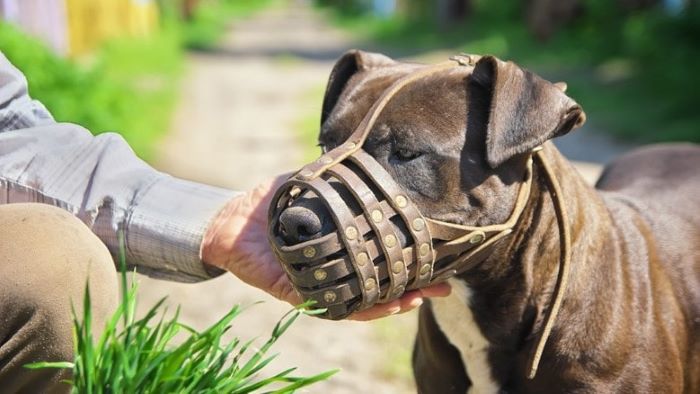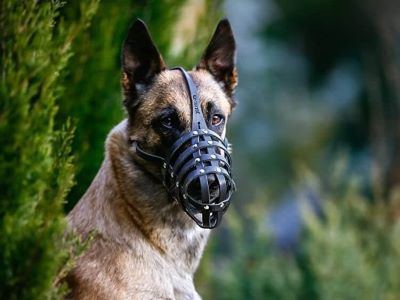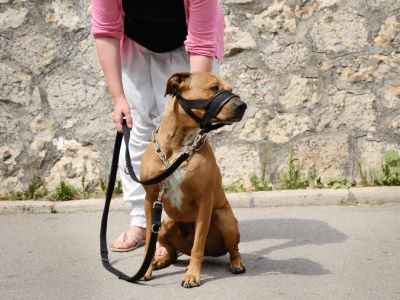Have you ever wondered the question, ‘How long can a dog wear a muzzle?‘ Worry not, In this article we will crack this muzzle mystery.

We are going to explore the various types of muzzles and learn how to care for your beloved pet in challenging situations, we are well-prepared for it all. So, without further ado, let’s embark on this adventure!
How Long Can a Dog Wear a Muzzle?
Your dog can wear a muzzle for up to 2 hours at a time, provided that their muzzle fits properly and they can drink water while wearing it. For more details let’s understand the different types of muzzles:
Basket Muzzles: These muzzles, with their plastic, rubber, or metal basket-like structure, allow dogs to pant, breathe, and take treats, making them one of the best dog muzzle uk options for extended wear like walks and vet visits.
Featuring bars or slats for airflow and visibility, they are comfortable for extended wear, ideal for activities such as walks and vet visits, ensuring easy breathing and temperature regulation.
Custom Muzzles: Designed to fit a dog’s unique characteristics, custom muzzles consider factors like size, shape, and specific needs. Custom muzzles are ideal for extended use when designed correctly, making them beneficial for dogs in rehabilitation or frequent working roles.
Soft Muzzles: Made from materials like nylon or mesh, these muzzles have a flexible, wrap-around design that snugly covers the dog’s nose and mouth. While they work well for quick tasks like nail trimming or grooming, they may not provide the same level of breathability for extended wear.

Factors Influencing Muzzle Duration
Here are some factors that collectively influence how long a dog can comfortably wear a muzzle:
- Purpose of Muzzling: The duration a dog can wear a muzzle varies depending on whether it’s used for training purposes or medical needs. Training muzzles are typically worn for shorter periods during training sessions, while medical muzzles may be needed for longer durations.
- Dog’s Temperament: The temperament of the dog plays a crucial role in determining how long a muzzle can be worn. Nervous or aggressive dogs may find extended wear more stressful, while calm dogs may tolerate it better.
- Duration of Wear: The intended duration of muzzle wear is a key factor. Muzzles worn for short-term activities like grooming or vet visits can be different from those intended for long-term use, such as for dogs in specific working roles or those with medical conditions.
- Muzzle Fit: Ensuring that the muzzle fits properly is essential for the dog’s comfort and safety. A well-fitted muzzle reduces the risk of discomfort and allows for longer wear. Chafing and discomfort can occur if the muzzle is too tight, too loose, or made from materials that irritate the dog’s skin.
Choosing the right fit and material can prevent problems and make your dog comfortable.

Short-Term vs. Long-Term Use
Here is the table to understand short-term and long-term muzzle use differences:
| Aspect | Short-term Muzzle Use | Long-term Muzzle Use |
|---|---|---|
| Purpose | Training and socialization, vet visits | Medical necessity, legal requirements, shelter |
| Introduction for New Dogs | Gradual introduction for puppies | May require adaptation over time |
| Duration | Sessions lasting 15-30 minutes, brief wear. | Temporary, during specific events or vet visits. |
| Medical Conditions | Temporary use post-surgery recovery | Chronic conditions may necessitate long-term |
| Legal Requirements | None | Breed-specific legislation or public safety |
| Behavioural Rehabilitation | May aid in behavioural training | Essential for dogs with behavioural issues |
| Comfort and Well-being | Focus on comfort during short use | Comfort and safety become paramount |
| Monitoring and Adjustments | Frequent checks and breaks | Periodic checks and adjustments as needed |
Monitoring and Care
It’s crucial to give your dog regular breaks from wearing the muzzle, especially during extended use. Short breaks allow them to eat, drink, and pant comfortably, let’s see some more suggested by AKC:
- Wash it regularly according to the manufacturer’s instructions. Ensure that your dog’s snout is also clean and dry before putting on the muzzle to prevent chafing or irritation.
- Check the muzzle’s fit and condition during these breaks to ensure it hasn’t become too loose or damaged, which could compromise its effectiveness. Keep the muzzle clean to prevent discomfort or skin issues.
- Bring familiar toys or treats to comfort the dog. Using a muzzle that allows for treats or food rewards during the visit.

Watch for signs that your dog may be distressed or uncomfortable while wearing the muzzle. These signs can include excessive pawing at the muzzle, whining, or trying to remove it. If your dog exhibits signs of distress, remove the muzzle immediately.
If your dog is new to wearing a muzzle, be sure to gradually muzzle train them first. Check out our guide on how to muzzle train a dog using treats, patience, and short initial wear times.
Alternatives to Extended Muzzle Wear
Consider behavioural training with a qualified dog trainer or behaviourist. They can address the root causes of any behavioural issues that may have led to muzzle use, working to improve your dog’s behaviour and reduce the need for a muzzle.
Create controlled environments, such as safe spaces at home or designated areas, to minimize your dog’s exposure to triggers or stressors, reducing the need for a muzzle.
Lastly, seek professional help if your dog’s behaviour poses challenges or safety concerns. These alternatives not only improve your dog’s quality of life but also strengthen the bond between you and your furry friend.
FAQs
Can We Use a Dog Muzzle for Biting?
Muzzles should NOT be used for things like stopping your dog from barking, chewing, or eating things off the ground or for a puppy who is playbiting. Work with a trainer for tips on how to deal with those issues. Things to remember when using a muzzle: Proper fit of the muzzle is very important!
Is It Okay to Leave a Muzzle on a Dog All Day?
A muzzle is only meant to be used for short periods of time, and only when your dog is supervised. Behavioural problems like barking and chewing are, by their nature, ongoing issues, so a muzzle, a tool meant for temporary and short-term use, is not a solution.
Are Muzzles Good or Bad?
Muzzles are useful preventative tools to keep dogs from engaging in dangerous behaviour with their mouths — and that doesn’t mean just biting. Muzzles can be especially helpful for dogs who like to eat non-food items. Let’s face it, dogs have a tendency to follow their nose, but occasionally that can lead them astray.
Conclusion
In conclusion, we have cracked the muzzle mystery of “How long can a dog wear a muzzle?” We covered various muzzle types and factors that affect their duration of use. Whether for training, medical needs, or legal requirements, each situation requires kind consideration.
To sum up, responsible muzzle use is essential. Monitor your dog’s well-being, provide breaks, keep the muzzle clean, and watch for distress signs. Remember, there are alternatives like training, controlled environments, and professional help to ensure your dog’s comfort and safety.
Ultimately, make informed choices about muzzling, prioritising your dog’s welfare. By doing so, you can ensure the well-being of your dog and strengthen your bond.
Be sure to measure your dog’s snout length and circumference to find the right size muzzle. Refer to our guide on how to measure a dog for a muzzle for step-by-step instructions. Choosing the right size and fit prevents rubbing and chafing during wear.



